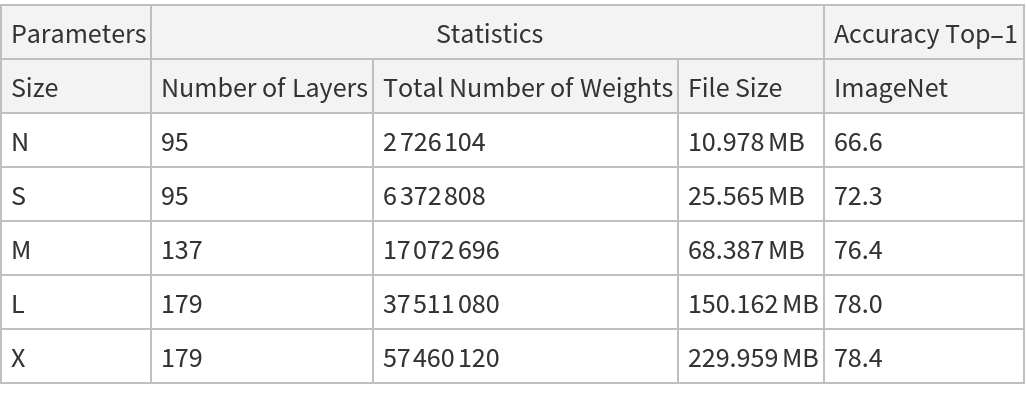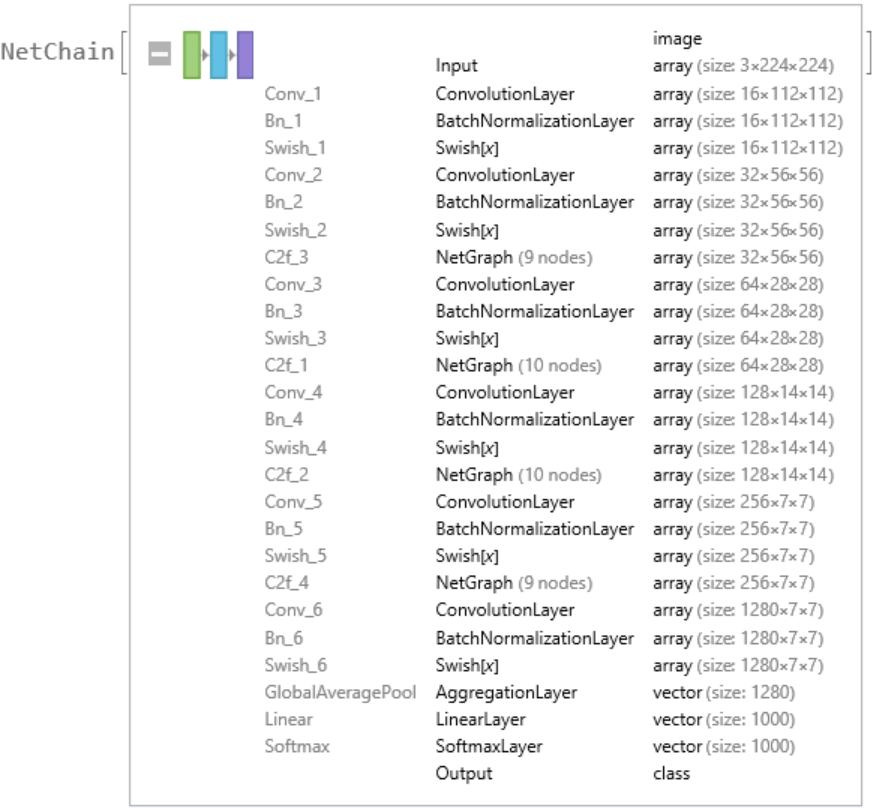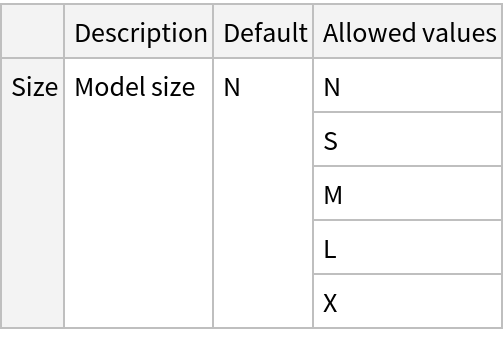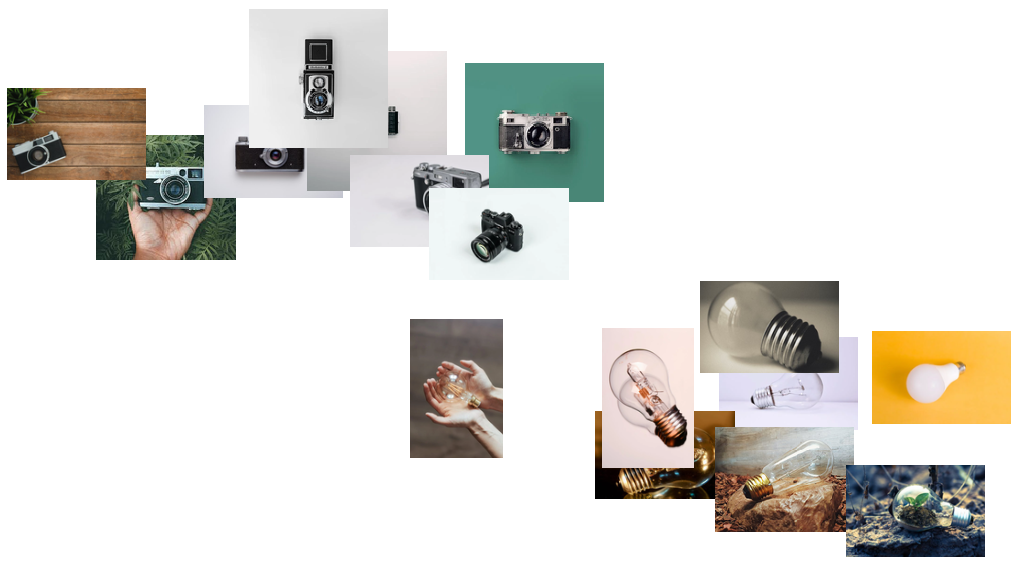Resource retrieval
Get the pre-trained net:
NetModel parameters
This model consists of a family of individual nets, each identified by a specific parameter combination. Inspect the available parameters:
Pick a non-default net by specifying the parameters:
Pick a non-default uninitialized net:
Basic usage
Classify an image:
The prediction is an Entity object, which can be queried:
Get a list of available properties of the predicted Entity:
Obtain the probabilities of the 10 most likely entities predicted by the net:
An object outside the list of the ImageNet classes will be misidentified:
Obtain the list of names of all available classes:
Feature extraction
Remove the last two layers of the trained net so that the net produces a vector representation of an image:
Get a set of images:
Visualize the features of a set of images:
Transfer learning
Use the pre-trained model to build a classifier for telling apart images of bulbs and cameras. Create a test set and a training set:
Remove the last classification layers from the pre-trained net:
Create a new net composed of the pre-trained net followed by a linear layer and a softmax layer:
Train on the dataset, freezing all the weights except for those in the "linearNew" layer (use TargetDevice -> "GPU" for training on a GPU):
Perfect accuracy is obtained on the test set:
Net information
Inspect the number of parameters of all arrays in the net:
Obtain the total number of parameters:
Obtain the layer type counts:
Display the summary graphic:
Export to ONNX
Export the net to the ONNX format:
Get the size of the ONNX file:
The size is similar to the byte count of the resource object:
Check some metadata of the ONNX model:
Import the model back into Wolfram Language. However, the NetEncoder and NetDecoder will be absent because they are not supported by ONNX:



![NetModel[{"YOLO V8 Classify Trained on ImageNet Competition Data", "Size" -> "M"}, "UninitializedEvaluationNet"]](https://www.wolframcloud.com/obj/resourcesystem/images/edd/edddfcbc-1fc4-4733-afab-168d2680d191/11320b0ffca3894e.png)
![(* Evaluate this cell to get the example input *) CloudGet["https://www.wolframcloud.com/obj/fb779ef2-8026-41a2-844d-f8b54ad9eedd"]](https://www.wolframcloud.com/obj/resourcesystem/images/edd/edddfcbc-1fc4-4733-afab-168d2680d191/4166d6b9fb6a8c84.png)

![(* Evaluate this cell to get the example input *) CloudGet["https://www.wolframcloud.com/obj/d3f275ad-e60d-46e8-a15c-198390779830"]](https://www.wolframcloud.com/obj/resourcesystem/images/edd/edddfcbc-1fc4-4733-afab-168d2680d191/6e8e497fc5f6be09.png)

![(* Evaluate this cell to get the example input *) CloudGet["https://www.wolframcloud.com/obj/6c04f2a3-c69d-4bca-82f5-a2ad1063394f"]](https://www.wolframcloud.com/obj/resourcesystem/images/edd/edddfcbc-1fc4-4733-afab-168d2680d191/33b4bd60d068b995.png)
![EntityValue[
NetExtract[
NetModel["YOLO V8 Classify Trained on ImageNet Competition Data"], "Output"][["Labels"]], "Name"]](https://www.wolframcloud.com/obj/resourcesystem/images/edd/edddfcbc-1fc4-4733-afab-168d2680d191/6b6f0158a43caae6.png)

![(* Evaluate this cell to get the example input *) CloudGet["https://www.wolframcloud.com/obj/db2a9da7-ed6c-4683-9ddf-d085510abc30"]](https://www.wolframcloud.com/obj/resourcesystem/images/edd/edddfcbc-1fc4-4733-afab-168d2680d191/6f4d710dcd890e1d.png)

![(* Evaluate this cell to get the example input *) CloudGet["https://www.wolframcloud.com/obj/a22e63e1-bd66-490c-9516-27f0fd2fddbf"]](https://www.wolframcloud.com/obj/resourcesystem/images/edd/edddfcbc-1fc4-4733-afab-168d2680d191/20645454d7db1177.png)
![(* Evaluate this cell to get the example input *) CloudGet["https://www.wolframcloud.com/obj/19d1f9a6-a833-4daa-9740-c822cf5c5a14"]](https://www.wolframcloud.com/obj/resourcesystem/images/edd/edddfcbc-1fc4-4733-afab-168d2680d191/474ce2204d82edd9.png)

![newNet = NetChain[<|"pretrainedNet" -> tempNet, "linearNew" -> LinearLayer[], "softmax" -> SoftmaxLayer[]|>, "Output" -> NetDecoder[{"Class", {"bulb", "camera"}}]]](https://www.wolframcloud.com/obj/resourcesystem/images/edd/edddfcbc-1fc4-4733-afab-168d2680d191/23fd8ffd55219d31.png)


![Information[
NetModel[
"YOLO V8 Classify Trained on ImageNet Competition Data"], "ArraysElementCounts"]](https://www.wolframcloud.com/obj/resourcesystem/images/edd/edddfcbc-1fc4-4733-afab-168d2680d191/50ae687271108279.png)

![Information[
NetModel[
"YOLO V8 Classify Trained on ImageNet Competition Data"], "ArraysTotalElementCount"]](https://www.wolframcloud.com/obj/resourcesystem/images/edd/edddfcbc-1fc4-4733-afab-168d2680d191/6317277d6b2ebd68.png)
![Information[
NetModel[
"YOLO V8 Classify Trained on ImageNet Competition Data"], "LayerTypeCounts"]](https://www.wolframcloud.com/obj/resourcesystem/images/edd/edddfcbc-1fc4-4733-afab-168d2680d191/53ae850485944cae.png)
![Information[
NetModel[
"YOLO V8 Classify Trained on ImageNet Competition Data"], "SummaryGraphic"]](https://www.wolframcloud.com/obj/resourcesystem/images/edd/edddfcbc-1fc4-4733-afab-168d2680d191/014904342adb6a74.png)
![onnxFile = Export[FileNameJoin[{$TemporaryDirectory, "net.onnx"}], NetModel["YOLO V8 Classify Trained on ImageNet Competition Data"]]](https://www.wolframcloud.com/obj/resourcesystem/images/edd/edddfcbc-1fc4-4733-afab-168d2680d191/6040bc9a9dd9f807.png)
